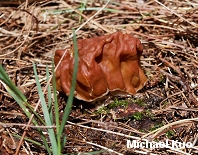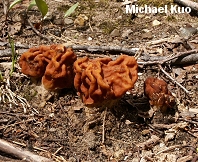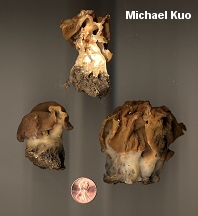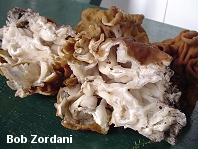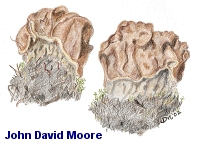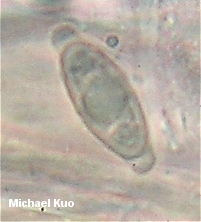| Major Groups > False Morels > Gyromitra korfii |

|
Gyromitra korfii [ Ascomycetes > Pezizales > Discinaceae > Gyromitra . . . ] by Michael Kuo "Gyromitra gigas," found in many field guides, is recognized among species of Gyromitra by its massive stem and its squarish, tightly adherent cap. Some mycologists split Gyromitra gigas into two species, Gyromitra korfii and Gyromitra montana. Gyromitra korfii has a stout, massive stem, and a tan to golden brown or brown cap. It is extremely difficult to distinguish from Gyromitra montana on the basis of field characteristics--although the two mushrooms do apparently grow in different places. Gyromitra korfii appears to be limited to territory east of the Rockies, while Gyromitra montana is apparently found in the Rockies and westward. Ultimately the two species should be separated on the basis of spore characteristics: the spores of Gyromitra korfii are fusoid and fairly thin (10-13 µ wide), featuring conspicuous blunt, knob-like ends when mature--while the spores of Gyromitra montana are ellipsoid and wide (11.5-15 µ wide), developing variable apiculi that are frequently less conspicuous. Officially, Gyromitra gigas is the correct current name for this species, since Abbott & Currah (1997) synonymized Gyromitra korfii and Gyromitra montana with Gyromitra gigas, and a more recent treatment does not exist. Abbott & Currah examined the spores of a gazillion putative Gyromitra montana specimens from the northern Rocky Mountains, together with spores of a North Carolina type collection of Gyromitra korfii and spores of three Scandinavian collections labelled Gyromitra gigas. The authors found that sporal "features overlap," and that Description: Ecology: Officially saprobic, but potentially also mycorrhizal--or, like the true morels, donning both ecological hats in the course of its life cycle; found under hardwoods in spring; east of the Rocky Mountains. I once found Gyromitra korfii growing out of the side of a dead big-toothed aspen, five feet above the ground! Cap: 3-10 cm high; 4-10 cm across; variable in shape but often blocky and squarish; sometimes vaguely lobed; tightly affixed; broadly wrinkled; convoluted; tan to brown, rarely cinnamon or tawny; undersurface whitish to pale brownish, ingrown with stem where contact occurs. Flesh: Whitish; brittle; chambered. Stem: 3-8 cm high; 2-6 cm wide; pale tan to whitish; bald; developing broad ribs or waves. Microscopic Features: Spores 25-37 x 10-13 µ; broadly fusiform, with a wide, knoblike apiculus (1-3.5 µ high and 3 µ wide) developing at each end with maturity; with one large oil droplet and numerous smaller droplets. Asci 8-spored. Paraphyses clavate to cylindric; with golden to brownish, orangish, or reddish contents. REFERENCES: (Raitvir, 1970) Harmaja, 1973. (Raitvir, 1970; Harmaja, 1973; Smith, Smith & Weber, 1981; Weber, 1995; Lincoff, 1992 [as "G. fastigiata"]; Abbott & Currah, 1997; Roody, 2003; McNeil, 2006; Kuo, 2005.) Herb. Kuo 05259503, 05170201, 04240302, 05010402, 05150401. This website contains no information about the edibility or toxicity of mushrooms. |
© MushroomExpert.Com |
|
Cite this page as: Kuo, M. (2012, June). Gyromitra korfii (Gyromitra gigas). Retrieved from the MushroomExpert.Com Web site: http://www.mushroomexpert.com/gyromitra_korfii.html |
